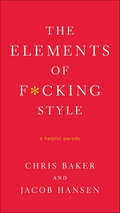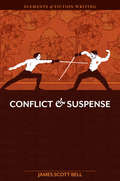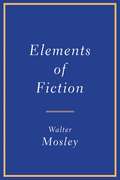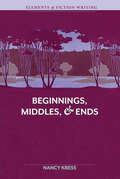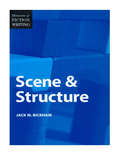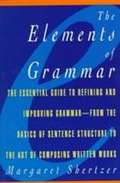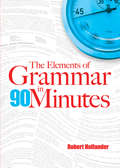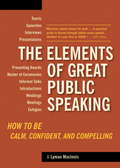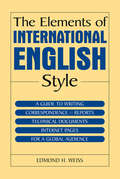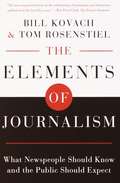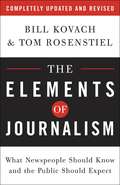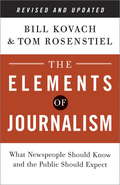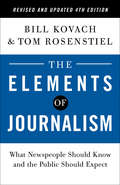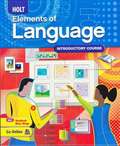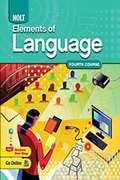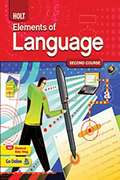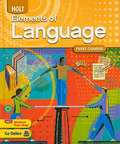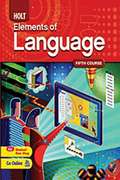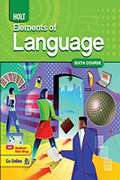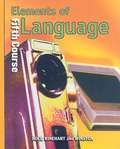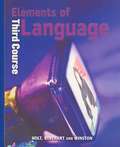- Table View
- List View
The Elements of F*cking Style: A Helpful Parody
by Chris Baker Jacob HansenThe truth about English is that it can get pretty boring. Dangling modifiers, gerunds, punctuation marks--it's enough to make you want to drop out of high school. Swearing and sex on the other hand, well, these time-honored pastimes warm the cockles of our hearts. Now, The Elements of F*cking Style drags English grammar out of the ivory tower and into the gutter, injecting a dull subject with a much-needed dose of color.This book addresses everything from common questions ("What the hell is a pronoun?") to philosophical conundrums ("Does not using paragraphs or periods make my thesis read like it was written by a mental patient?"). Other valuable sections include:•All I've got in this world are my sentences and my balls, and I don't break 'em for nobody •A colon is more than an organ that gets cancer•Words your bound to f*ck up One glance at your friend's blog should tell you everything you need to know about the sorry state of the English language. This book gives you the tools you need to stop looking like an idiot on message boards and in interoffice memos. Grammar has never before been so much f*cking fun.
Elements of Fiction Writing: Conflict & Suspense (Elements Of Fiction Writing Ser.)
by James Scott BellRamp up the tension and keep your readers hooked! Inside you'll find everything you need to know to spice up your story, move your plot forward, and keep your readers turning pages. Expert thriller author and writing instructor James Scott Bell shows you how to craft scenes, create characters, and develop storylines that harness conflict and suspense to carry your story from the first word to the last. Learn from examples of successful novels and movies as you transform your work from ho-hum to high-tension. Pack the beginning, middle, and end of your book with the right amount of conflict. Tap into the suspenseful power of each character's inner conflict. Build conflict into your story's point of view. Balance subplots, flashbacks, and backstory to keep your story moving forward. Maximize the tension in your characters' dialogue. Amp up the suspense when you revise. Conflict & Suspenseoffers proven techniques that help you craft fiction your readers won't be able to put down.
The Elements Of Fiction Writing: Meditations On The Structure Of Revelation
by Walter MosleyIn his essential writing guide, This Year You Write Your Novel, Walter Mosley supplied aspiring writers with the basic tools to write a novel in one year. In this com-plementary follow up, Mosley guides the writer through the elements of not just any fiction writing, but the kind of writing that transcends convention and truly stands out. How does one approach the genius of writers like Melville, Dickens, or Twain? In The Elements of Fiction, Walter Mosley contemplates the answer. <p><p> In a series of instructive and conversational chapters, Mosley demonstrates how to master fiction's most essential elements: character and char-acter development, plot and story, voice and narrative, context and description, and more. The result is a vivid depiction of the writing process, from the blank page to the first draft to rewriting, and rewriting again. Throughout, The Elements of Fiction is enriched by brilliant demonstrative examples that Mosley himself has written here for the first time. <p> Inspiring, accessible, and told in a voice both trustworthy and wise, The Elements of Fiction writing will intrigue and encourage writers and readers alike.
Elements of Fiction Writing - Beginnings, Middles & Ends (Elements Of Fiction Writing Ser.)
by Nancy KressGet Your Readers' Attention - And Keep It - From the First World to the Final Page Translating that initial flash of inspiration into a complete story requires careful crafting. So how do you keep your story from beginning slowly, floundering midway, and trailing off at the end? Nancy Kress shows you effective solutions for potential problems at each stage of your story--essential lessons for strong start-to-finish storytelling. Hook readers, agents, and editors in the first three paragraphs. Make and keep your story's implicit promise to the reader. Build drama and credibility by controlling your prose. Consider the price a writer pays for flashbacks. Reveal character effectively throughout your story. Get the tools you need to get your story off to an engaging start, keep the middle tight and compelling, and make your conclusion high impact. You'll also find dozens of exercises to help strengthen your short story or novel. Let this resource be your guide to successful stories-from the first word to the last.
Elements of Fiction Writing - Scene & Structure (Elements of Fiction Writing)
by Jack BickhamCraft your fiction with scene-by-scene flow, logic and readability. An imprisoned man receives an unexpected caller, after which "everything changed..." And the reader is hooked. But whether or not readers will stay on for the entire wild ride will depend on how well the writer structures the story, scene by scene. This book is your game plan for success. Using dozens of examples from his own work - including Dropshot, Tiebreaker and other popular novels - Jack M. Bickham will guide you in building a sturdy framework for your novel, whatever its form or length. You'll learn how to: "worry" your readers into following your story to the end prolong your main character's struggle while moving the story ahead juggle cause and effect to serve your story action As you work on crafting compelling scenes that move the reader, moment by moment, toward the story's resolution, you'll see why... believable fiction must make more sense than real life every scene should end in disaster some scenes should be condensed, and others built big Whatever your story, this book can help you arrive at a happy ending in the company of satisfied readers.
The Elements Of Grammar
by Margaret Shertzer<P>The essential guide to refining and improving grammar – from the basics of sentence structure to the art of composing written works.<P> A concise, comprehensive handbook of the basic rules of grammar and usage that presents invaluable tips on how to implement these rules in everyday writing and speaking. <P>Succinct and immensely practical with coverage of punctuation, capitalization, the parts of the sentence, words often confused, foreign words and phrases, numbers, signs, and symbols, etc.
The Elements of Grammar in 90 Minutes
by Robert HollanderAn eminent scholar explains the essentials of English grammar to those who never studied the basics as well as those who need a refresher course. Inspired by Strunk & White's classic The Elements of Style, this user-friendly guide focuses exclusively on grammar, explaining the individual parts of speech and their proper arrangement in sentence form. A modest investment of 90 minutes can provide readers of all ages with simple but important tools that will improve their communication skills. Dover (2011) original publication.
The Elements of Great Public Speaking: How to Be Calm, Confident, and Compelling
by J. Lyman MacinnisGreat speakers aren't just born; they prepare and they practice. THE ELEMENTS OF GREAT PUBLIC SPEAKING takes the fear out of taking the podium, distilling essential techniques and tricks for just about any speaking occasion. Experienced businesspeople, nervous students, best men, and eulogists alike can benefit from the author's simple, direct, and tested advice on everything from body language and word choice to responding to the audience and overcoming stage fright. Because there's no such thing as a boring topic Äîjust boring speakers ÄîELEMENTS shows how to look, sound, and act like someone worth listening to.Reviews ÄúThe go-to guide for anyone about to stand up and say something. . . A practical guide to thumb through before every speech, whether it's your first or 500th. Äù ÄîUSA Today
The Elements of International English Style: A Guide to Writing Correspondence, Reports, Technical Documents, and Internet Pages for a Global Audience
by Edmond H. WeissThis easy-to-use handbook is an essential resource for anyone who needs to write English correspondence for an international business audience. In an engaging, accessible style it integrates the theory and controversies of intercultural communication with the practical skills of writing and editing English for those who read it as a second language. The book emphasizes principles of simplicity and clarity, proper etiquette, cultural sensitivity, appropriate layout and typography, and more to increase the chances that a text prepared by a native English speaker will be better understood by a non-native speaker. It also updates traditional advice with new insights into "e-mail culture." Equally useful for students and professionals in business communication, marketing communication, and international business, The Elements of International English Style is filled with realistic examples, problems, and projects, including: 57 specific tactics to internationalize one's English; hundreds of before-and-after comparisons showing the effects of editing for an international audience; models of international correspondence; practical discussion questions and work projects; useful resources for further study, including books, articles, and websites.
The Elements of Journalism: What Newspeople Should Know and the Public Should Expect
by Bill Kovach Tom RosenstielIn July 1997, twenty-five of America's most influential journalists sat down to try and discover what had happened to their profession in the years between Watergate and Whitewater. What they knew was that the public no longer trusted the press as it once had. They were keenly aware of the pressures that advertisers and new technologies were putting on newsrooms around the country. But, more than anything, they were aware that readers, listeners, and viewers — the people who use the news — were turning away from it in droves. <P><P> There were many reasons for the public's growing lack of trust. On television, there were the ads that looked like news shows and programs that presented gossip and press releases as if they were news. There were the "docudramas," television movies that were an uneasy blend of fact and fiction and which purported to show viewers how events had "really" happened. At newspapers and magazines, celebrity was replacing news, newsroom budgets were being slashed, and editors were pushing journalists for more "edge" and "attitude" in place of reporting. And, on the radio, powerful talk personalities led their listeners from sensation to sensation, from fact to fantasy, while deriding traditional journalism. Fact was blending with fiction, news with entertainment, journalism with rumor. <P> Calling themselves the Committee of Concerned Journalists, the twenty-five determined to find how the news had found itself in this state. Drawn from the committee's years of intensive research, dozens of surveys of readers, listeners, viewers, editors, and journalists, and more than one hundred intensive interviews with journalists and editors, The Elements of Journalism is the first book ever to spell out — both for those who create and those who consume the news — the principles and responsibilities of journalism. Written by Bill Kovach and Tom Rosenstiel, two of the nation's preeminent press critics, this is one of the most provocative books about the role of information in society in more than a generation and one of the most important ever written about news. By offering in turn each of the principles that should govern reporting, Kovach and Rosenstiel show how some of the most common conceptions about the press, such as neutrality, fairness, and balance, are actually modern misconceptions. They also spell out how the news should be gathered, written, and reported even as they demonstrate why the First Amendment is on the brink of becoming a commercial right rather than something any American citizen can enjoy. <P> The Elements of Journalism is already igniting a national dialogue on issues vital to us all. This book will be the starting point for discussions by journalists and members of the public about the nature of journalism and the access that we all enjoy to information for years to come. <P>
The Elements of Journalism: What Newspeople Should Know and the Public Should Expect
by Bill Kovach Tom RosenstielThe Book That Every Citizen and Journalist Should Read. "What this book does better than any single book on media history, ethics, or practice is weave [together] why media audiences have fled and why new technology and megacorporate ownership are putting good journalism at risk." --Rasmi Simhan, Boston Globe
The Elements of Journalism, Revised and Updated 3rd Edition
by Tom Rosenstiel Bill KovachThe Book That Every Citizen and Journalist Should Read"What this book does better than any single book on media history, ethics, or practice is weave . . . [together] why media audiences have fled and why new technology and megacorporate ownership are putting good journalism at risk." --Rasmi Simhan, Boston Globe"Kovach and Rosenstiel's essays on each [element] are concise gems, filled with insights worthy of becoming axiomatic. . . . The book should become essential reading for journalism professionals and students and for the citizens they aim to serve." --Carl Sessions Stepp, American Journalism Review"If you think journalists have no idea what you want . . . here is a book that agrees with you. Better--it has solutions. The Elements of Journalism is written for journalists, but any citizen who wonders why the news seems trivial or uninspiring should read it." --Marta Salij, Detroit Free PressThe elements of journalism are:* Journalism's first obligation is to the truth.* Its first loyalty is to citizens.* Its essence is a discipline of verification.* Its practitioners must maintain an independence from those they cover.* It must serve as an independent monitor of power.* It must provide a forum for public criticism and compromise.* It must strive to make the significant interesting and relevant.* It must keep the news comprehensive and proportional.* Its practitioners must be allowed to exercise their personal conscience.
The Elements of Journalism, Revised and Updated 4th Edition: What Newspeople Should Know And The Public Should Expect
by Bill Kovach Tom RosenstielA timely new edition of the classic journalism text, now featuring updated material on the importance of reporting in the age of media mistrust and fake news—and how journalists can use technology to navigate its challengesMore than two decades ago, the Committee of Concerned Journalists gathered some of America&’s most influential newspeople and asked them, &“What is journalism for?&” Through exhaustive research, surveys, interviews, and public forums, the committee identified the essential elements that define journalism and its role in our society. The result is one of the most important books on media ever written—winner of the Goldsmith Book Prize from Harvard, a Society of Professional Journalists Award, and the Bart Richards Award for Media Criticism from Penn State University.Updated with new material covering the ways journalists can leverage technology to their advantage, especially given the shifting revenue architecture of news—and with the future of news, facts, and democracy never more in question—this fourth edition of The Elements of Journalism is the authoritative guide for journalists, students, and anyone hoping to stay informed in contentious times.
Elements of Language: Introductory Course
by Renee Hobbs Richard Vacca Judith L. Irvin Lee OdellTextbook.
Elements Of Language: Grammar, Usage and Mechanics - Language Skills Practice for Chapters 10-26
by Holt Rinehart Winston StaffMost of the worksheets you will find in this workbook are traditional worksheets providing practice and reinforcement activities on every rule and on all major instructional topics in the grammar, usage, and mechanics chapters in Elements of Language.
Elements of Language: Second Course
by Judith L. Irvin Lee Odell Richard Vacca Renée HobbsNIMAC-sourced textbook
Elements of Language: First Course
by Judith L. Irvin Lee Odell Richard Vacca Renée HobbsNIMAC-sourced textbook
Elements of Language: Fifth Course
by Lee Odell Judith L. Irvin Richard Vacca Renée HobbsNIMAC-sourced textbook
Elements of Language: Sixth Course
by Lee Odell Judith L. Irvin Richard Vacca Renee HobbsNIMAC-sourced textbook
Elements of Language: Fifth Course
by Lee Odell Richard Vacca Renee HobbsThis book presents a fundamental approach to the teaching and learning of language.
Elements of Language: Sixth Course
by Lee Odell Richard Vacca Renee HobbsThis book guides to developing your skill as an effective and critical language user-a communicator in the twenty-first century.
Elements of Language: First Course
by Lee Odell Richard Vacca Renée Hobbs Judith IrvinElements of Language can be an important resource by helping you use language more effectively as you communicate in the twenty-first century.
Elements of Language: Introductory Course
by Lee Odell Richard Vacca Renee Hobbs Judith L. IrvinThe book "Elements of Language" is an important resource by helping students use language more effectively as they communicate in the twenty-first century.
Elements of Language: Third Course
by Holt Rinehart WinstonPut the communication strategies in Elements of Language to work by logging on to the Internet. At the Elements of Language Internet site, you can dissect the prose of professional writers, crack the codes of the advertising industry, and find out how your communication skills can help you in the real world.
